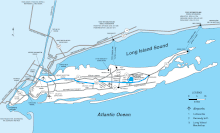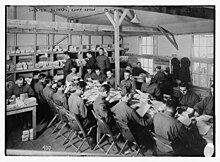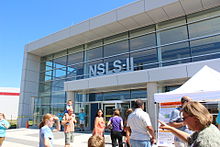
Particle physics or high-energy physics is the study of fundamental particles and forces that constitute matter and radiation. The field also studies combinations of elementary particles up to the scale of protons and neutrons, while the study of combination of protons and neutrons is called nuclear physics.

Fermi National Accelerator Laboratory (Fermilab), located in Batavia, Illinois, near Chicago, is a United States Department of Energy national laboratory specializing in high-energy particle physics.
ISABELLE was a 200+200 GeV proton–proton colliding beam particle accelerator partially built by the United States government at Brookhaven National Laboratory in Upton, New York, before it was cancelled in July, 1983.

The Relativistic Heavy Ion Collider is the first and one of only two operating heavy-ion colliders, and the only spin-polarized proton collider ever built. Located at Brookhaven National Laboratory (BNL) in Upton, New York, and used by an international team of researchers, it is the only operating particle collider in the US. By using RHIC to collide ions traveling at relativistic speeds, physicists study the primordial form of matter that existed in the universe shortly after the Big Bang. By colliding spin-polarized protons, the spin structure of the proton is explored.

The United States Department of Energy National Laboratories and Technology Centers is a system of laboratories overseen by the United States Department of Energy (DOE) for scientific and technological research. The primary mission of the DOE national laboratories is to conduct research and development (R&D) addressing national priorities: energy and climate, the environment, national security, and health. Sixteen of the seventeen DOE national laboratories are federally funded research and development centers administered, managed, operated and staffed by private-sector organizations under management and operating (M&O) contracts with the DOE. The National Laboratory system was established in the wake of World War II, during which the United States had quickly set-up and pursued advanced scientific research in the sprawling Manhattan Project.
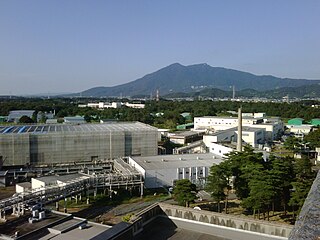
The High Energy Accelerator Research Organization, known as KEK, is a Japanese organization whose purpose is to operate the largest particle physics laboratory in Japan, situated in Tsukuba, Ibaraki prefecture. It was established in 1997. The term "KEK" is also used to refer to the laboratory itself, which employs approximately 695 employees. KEK's main function is to provide the particle accelerators and other infrastructure needed for high-energy physics, material science, structural biology, radiation science, computing science, nuclear transmutation and so on. Numerous experiments have been constructed at KEK by the internal and international collaborations that have made use of them. Makoto Kobayashi, emeritus professor at KEK, is known globally for his work on CP-violation, and was awarded the 2008 Nobel Prize in Physics.

High-energy nuclear physics studies the behavior of nuclear matter in energy regimes typical of high-energy physics. The primary focus of this field is the study of heavy-ion collisions, as compared to lighter atoms in other particle accelerators. At sufficient collision energies, these types of collisions are theorized to produce the quark–gluon plasma. In peripheral nuclear collisions at high energies one expects to obtain information on the electromagnetic production of leptons and mesons that are not accessible in electron–positron colliders due to their much smaller luminosities.

Raymond Davis Jr. was an American chemist and physicist. He is best known as the leader of the Homestake experiment in the 1960s-1980s, which was the first experiment to detect neutrinos emitted from the Sun; for this he shared the 2002 Nobel Prize in Physics.

The Cornell Laboratory for Accelerator-based ScienceS and Education (CLASSE) is a particle accelerator facility located in Wilson Laboratory on the Cornell University campus in Ithaca, NY. CLASSE was formed by merging the Cornell High-Energy Synchrotron Source (CHESS) and the Laboratory for Elementary-Particle Physics (LEPP) in July 2006. Nigel Lockyer is the Director of CLASSE in spring of 2023.
The National Synchrotron Light Source (NSLS) at Brookhaven National Laboratory (BNL) in Upton, New York was a national user research facility funded by the U.S. Department of Energy (DOE). Built from 1978 through 1984, and officially shut down on September 30, 2014, the NSLS was considered a second-generation synchrotron.
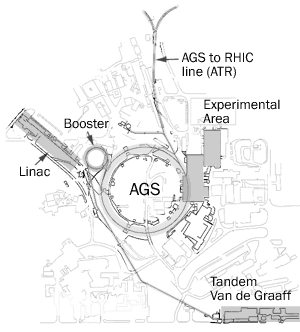
The Alternating Gradient Synchrotron (AGS) is a particle accelerator located at the Brookhaven National Laboratory in Long Island, New York, United States.
The NASA Space Radiation Laboratory (NSRL, previously called Booster Applications Facility), is a heavy ion beamline research facility; part of the Collider-Accelerator Department of Brookhaven National Laboratory, located in Upton, New York on Long Island. Its primary mission is to use ion beams (H+to Bi83+) to simulate the cosmic ray radiation fields that are more prominent beyond Earth's atmosphere.
Nicholas P. Samios is an American physicist and former director of the Brookhaven National Laboratory in Upton, New York.

Sam Aronson is an American physicist, formerly president of the American Physical Society in 2015 and also formerly the director of the Brookhaven National Laboratory from 2006 to 2012.
Ady Hershcovitch is a plasma physicist best known for his 1995 invention, the plasma window, which was later patented.. In the plasma window, a plasma separates air from a vacuum by preventing the air from rushing into the vacuum. This scientific development can facilitate non-vacuum ion material modification, manufacturing of superalloys, and high-quality non-vacuum electron-beam welding. The device has been compared to the force field in the Star Trek TV series. He is well known for his work in plasma physics at Brookhaven National Laboratory. He has over 80 publications and 15 patents.
Fulvia Pilat is an Italian-American physicist who is currently the Research Accelerator Division Director at the Spallation Neutron Source and an elected fellow of the American Physical Society (APS).

Christine Angela Aidala is an American high-energy nuclear physicist, Alfred P. Sloan Research Fellow and Associate Professor of Physics at the University of Michigan. She studies nucleon structure and parton dynamics in quantum chromodynamics.
An electron–ion collider (EIC) is a type of particle accelerator collider designed to collide spin-polarized beams of electrons and ions, in order to study the properties of nuclear matter in detail via deep inelastic scattering. In 2012, a whitepaper was published, proposing the developing and building of an EIC accelerator, and in 2015, the Department of Energy Nuclear Science Advisory Committee (NSAC) named the construction of an electron–ion collider one of the top priorities for the near future in nuclear physics in the United States.
The National User Facilities are a set of large-scale scientific facilities maintained by the U.S. Department of Energy, Office of Science, whose roles are to provide the scientific community with world-leading scientific instruments to enable research. These facilities are generally free to use, and are open to scientists from all over the world, usually through the submission and evaluation of research proposals.

Ilan Ben-Zvi is an accelerator physicist and academic. He was the associate chair for accelerator R&D at the Collider-Accelerator Department (C-AD), and is a distinguished scientist emeritus at the Collider-Accelerator Department (C-AD) at Brookhaven National Laboratory.



